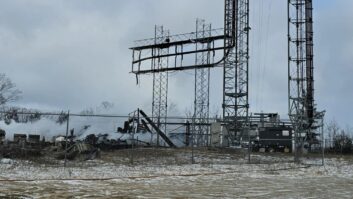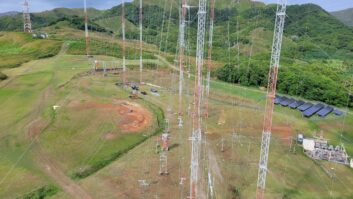(click thumbnail)Warm transmitter components may attract snakes.Dave Ernewein writes that he has enjoyed Workbench for years and looks forward to learning a new trick every now and then. He serves as a contract engineer for a number of facilities and has seen some “very familiar” things depicted in this column.
Among reader favorites are photos of odd things found at transmitter sites. Dave included pictures of a site where a Harris DAX-5 was not sealed properly when it was installed.
Opening up the transmitter for some routine maintenance, Dave met two snakes that had crawled up inside the lower portion of the transmitter. Fortunately, nothing got shorted out in Fig. 1. But in the second image, it looks like the snake has taken a mouthful of resistors.
Make sure you seal cable entry points to keep snakes and rodents out of your transmitter. This can be as simple as stuffing steel wool in the cable openings.
Long-time readers will remember the picture of a bird’s claws stuck to a cable feeding an AM tower with a horrendous base impedance. Dave was working at a station with his son Jeff shortly after that photo hit the pages of RW. Jeff came running into the transmitter building holding a smoldering squirrel by the tail!
His son saw the squirrel running across a power line; when it touched the transformer, the squirrel erupted in a fireball and ended up with a 2 inch hole in it. It would have made an interesting video.
(click thumbnail)Rough edges of circuit boards and components can help a snake shed its skin.Like many of us, Dave started in broadcasting as an announcer, then migrated to engineering. He finds himself working as a contract engineer because, as he puts it, “It’s the only way you can receive decent compensation for your services.”
Though he works in the Minneapolis area, Dave is wrapping up a total rebuild to a hurricane-destroyed station in Florida. Like his dad, Jeff has paid his dues in broadcasting, now handling the engineering operations for a TV ENG/SAT truck. An avid photographer, Jeff improved the resolution of the snake pictures shown in Figs. 1 and 2. Neat to see that his interest in critters around the transmitter site hasn’t waned.
* * *
Harry Bingaman, director of engineering for Sunbury Broadcasting in Sunbury, Pa., cautions engineers to check attic crawl spaces in transmitter buildings this time of year. You might be surprised what you find — like the active hornet’s nest in Fig. 3.
This kind of infestation is common at many sites. But a spritz of hornet spray under the building eaves may keep these varmints from nesting at your building. The spray also will be absorbed by any existing nests, destroying them.
* * *
(click thumbnail)Who knows what’s lurking in your transmitter building attic?Ed Treese provides broadcast technical services in Kansas and says uses his digital camera more than an oscilloscope!
The camera can, among other things, help refresh his memory when he is ordering parts to fix items like AM RF contactors in an ATU that may not be convenient to a phone.
In talking to our RF service techs at BE, I’ve heard this suggestion used to identify transmitter parts, especially when there is no schematic. The compact size of many digital cameras makes them ideal to snap a picture behind a transformer to check on wiring, too.
* * *
In a column in November, I postulated that copper was becoming the new gold, given all the thefts of strap, ground radials, and even ground wires.
Paul Sagi, a frequent Workbench contributor all the way from Kuala Lumpur, writes that even in Malaysia, the neutral earthing bus, which is copper, often is stolen from electric utility substations. In Malaysia, their power is three-phase, four-wire. Most homes are fed a single phase and a neutral, so the phase-to-neutral voltage is 240.
The fun begins when the neutral bus is removed. The voltage rises to 415, which is the phase-to-phase voltage, damaging lights and other items in homes and businesses that are fed single-phase power.
The electric utility claims it has no responsibility and will not entertain claims for compensation. There is a law in Kuala Lumpur saying the utility cannot be sued. Paul adds that there have been times when phone service has been lost, sometimes for a length of time, because someone came and stole the phone cable that runs along the street.
Theft of various metals, including copper, are in the newspapers from time to time, he says. But it’s not just wire. Drain gratings, even steel manhole covers disappear from roads, as do guard rails from highways.















